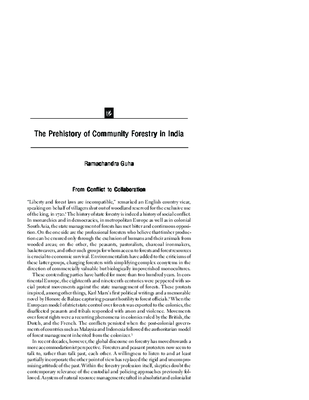The prehistory of community forestry in India
This journal article describes the history of forest policy in India, beginning with the construction of a railway network that initiated a massive demand for and depletion of timber resources. This period in India’s history gave rise to the realization that the subcontinent’s forests were exhaustible, which then incited decades of conflict. Early conflicts were fueled by government claims on land that traditionally had been used by forest communities. Some public figures argued against this policy, but their objections were disregarded and their writings did not spark change. Examples are given, such as Poona Sarvajanik Sabh, who called for partnerships with communities and a democratic system of forest policy that would have been much like Vrikshamitra (Friends of the Trees) Awards, which only emerged in Indian policy 110 years later. Current examples are given of the same issues, such as the Chipko Movement of the 1970s. The author divides India’s forest policy history into phases: the politics of blame, the politics of negotiation, the politics of collaboration, and the current potential for politics of partnership. Policies made during these different phases have affected community attitudes and subsequent treatment of forests. It appears that policy changes have resulted only from sustained pressure by social movements. Recommendations are based on these observable patterns, notably: Communities must have a long-term stake in maintaining forests; Benefits must be shared between state and communities; Community controlled areas should compliment strictly protected areas; Community demands must be respected; Governments should not overestimate their ability to control forest use; Follow-through on agreed courses of actions should be dependable.
https://biodiversitylinks.org/library/resources/rmp/library/content/tools/community-based-natural-forest-management-USAID-Lessons-Learned/cbnfm/USAID-BDB-cd-2-data/india-guha.pdf/view
https://biodiversitylinks.org/library/resources/rmp/library/content/tools/community-based-natural-forest-management-USAID-Lessons-Learned/cbnfm/USAID-BDB-cd-2-data/india-guha.pdf/@@download/image/image.png
File
The prehistory of community forestry in India
This journal article describes the history of forest policy in India, beginning with the construction of a railway network that initiated a massive demand for and depletion of timber resources. This period in India’s history gave rise to the realization that the subcontinent’s forests were exhaustible, which then incited decades of conflict. Early conflicts were fueled by government claims on land that traditionally had been used by forest communities. Some public figures argued against this policy, but their objections were disregarded and their writings did not spark change. Examples are given, such as Poona Sarvajanik Sabh, who called for partnerships with communities and a democratic system of forest policy that would have been much like Vrikshamitra (Friends of the Trees) Awards, which only emerged in Indian policy 110 years later. Current examples are given of the same issues, such as the Chipko Movement of the 1970s. The author divides India’s forest policy history into phases: the politics of blame, the politics of negotiation, the politics of collaboration, and the current potential for politics of partnership. Policies made during these different phases have affected community attitudes and subsequent treatment of forests. It appears that policy changes have resulted only from sustained pressure by social movements. Recommendations are based on these observable patterns, notably: Communities must have a long-term stake in maintaining forests; Benefits must be shared between state and communities; Community controlled areas should compliment strictly protected areas; Community demands must be respected; Governments should not overestimate their ability to control forest use; Follow-through on agreed courses of actions should be dependable.



